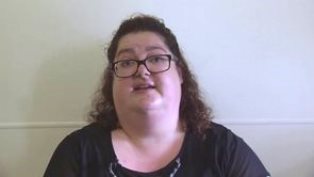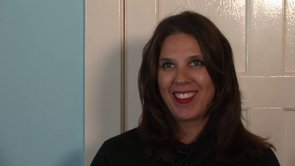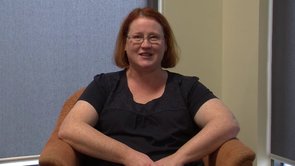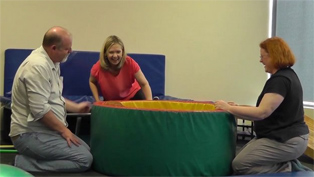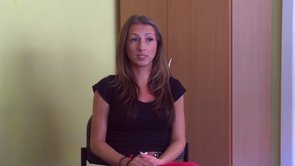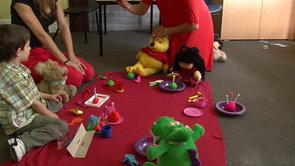The Therapy Process
The process of therapy is fluid. That means that it is constantly changing and adapting to suit the needs of your child and to reflect the progress that your child makes along their therapy journey.
The therapy process includes the following elements that need to be revisited regularly; assessment, goal development, and the delivery of the therapy. Click on each part of the therapy wheel below to learn more about each element.

Assessment
Assessment (also called ‘evaluation’, ‘review’, or ‘follow up’) is an important part of the therapy process. It helps the therapist to measure your child’s skills and abilities, and highlights areas of difficulty.
The initial assessment happens before therapy begins. This gives the therapist a ‘baseline’ of your child’s skills and abilities, and helps to set individualised goals for your child based on their strengths and challenges.
Once therapy begins, the therapist will do follow-up assessment at different time points. This allows you to measure the progress that your child has made over time.
For example, before starting therapy, Michael completes an assessment with his speech pathologist. The assessment shows that he can label five objects by name. After two months of therapy, the speech pathologist assesses him again. This time, Michael can name 20 objects. By testing Michael’s skills over these two time points, the therapist can measure his progress.
There are many different types of assessment that measure different skills and abilities in a number of different areas. Your therapist might choose to conduct formal standardised assessments, informal non-standardised assessments, or a combination of both.
The PDF below gives more information about standardised and non-standardised assessments, and when each can be used.
Goal Setting
After the assessment process, the therapist will look at your child’s skills, abilities, and difficulties. Together with the information you told them about your child’s development, the therapist will develop some goals for therapy. Parents play an active role in this process.
Once the goals have been set for your child, your therapist may write these goals into a therapy plan or goal sheet. This is a useful tool to focus therapy, and it is a way to measure your child’s progress in different areas over time.
"If you just break it up with three little goals, work on them, get them perfect, then move onto the next three goals that helps." - Paula, Parent
The therapy plan or goal sheet can be written in a number of ways, and will look different from therapist to therapist. It doesn’t matter what it looks like; the most important thing is that it helps you to understand what skills your child is working on, and when the therapist will review your child’s progress.
Your child will do best if everyone in your child’s team receives a copy of the therapy plan or goal sheet so that everyone is on the same page.
Click on the button below to learn about SMART goals.
Therapy
Once the therapy goals have been set for your child, therapy sessions will begin.
It is important that you play an active role in your child's therapy, both during therapy sessions and when developing a goal plan for your child. For more information on the important role parents play, see the section on Producing Best Outcomes.
"The parent is a really pivotal part of the team and it is important to make sure that the parent feels like they are driving the bus, we will often give them the guidance and give them the road map but they really need to feel like they are in charge. They are the ones that know their child best, they are the ones that have the difficult times at home as well as celebrating the positive times and they are the ones that need to be equipped with the skills as their children develop." Stephanie Crawford, Speech Pathologist
The development of a therapy plan will happen after the assessment process, and the way that this happens will vary from therapist to therapist. Below are two examples of therapy plans from children we have seen in previous videos.
Therapy plans in action!
Ryan's therapy plan
Ryan is seven and a half years old and has been attending therapy since receiving a diagnosis at 20 months of age.
Click the button below to download an excerpt from Ryan's occupational therapy plan.
Ryan occupational therapy plan example
Ryder's therapy plan
Ryder is almost 5, and was diagnosed with ASD at 15 months of age. Shortly after receiving a diagnosis, he commenced speech therapy.
Click the button below to download an excerpt from Ryder's speech therapy plan.
Ryder speech therapy plan example
